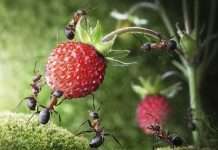Birds are often viewed as gardeners’ best friends since they feed on common pests such as slugs or aphids. However, some species can be a nuisance to gardens, too. For example, blackbirds can ravage the ripening fruits, sparrows can shred the flowers, and other seed-eaters can ruin your seedlings or new lawns.
So, how to keep birds from eating garden plants? Here are the most effective and humane ways to ward off these high flyers.
How To Keep Birds From Eating Garden Plants
Cover Plants With Netting
While building bird netting can take some effort and time, it is one of the most effective bird deterrents for gardens.
Start with creating hoops that extend from one side of the garden bed to the other. You can use cheap, common-used PVC pipes for this. Next, cover bird or butterfly netting over them before using wire or landscape pins to secure the setup to the ground.
We recommend using high-grade, UV-resistant nets so the setup can last longer. Cheaper alternatives often break down or shred, which are not only a hassle to rebuild but also put other unharmful wildlife at threat.
Use Chicken Wire
You may want to cover your plants with chicken wire. This option is ideal for both newly-planted seeds or fully grown produce and plants. For new seedlings, pin panels of chicken wire to the ground to protect them from nibbling birds or chickens. As seedlings grow, raise the fence off the ground using stakes, bricks, or boards for extra protection.
Build A Scarecrow
Common stationary decoys such as scarecrows scare the birds and other potential pests away. Yet, remember that scarecrows only work if you reposition them regularly, as birds can view these items as harmless.
If you’re building scarecrows yourself, make sure to erect them on a stake that allows you to pull them up and relocate them to another section of the garden. Dressing the decoys up with vibrant colors such as yellow and red might also help. These hues are believed to trigger the birds to flight.
Plastic Predators
There are artificial owls that are made to frighten the birds away. Simply place them in the spot that welcomes the highest traffic of birds and remember to move them regularly (so birds will think they’re the real deal!). These fake critters spin by the gust of the wind and creates sounds that imitate when they’re launching an attack to scare the birds off the land.
Garden Fleece
Originally designed to protect crops from frost, garden fleece can be used to deter intrusive birds from entering the garden beds. Drape the fleece over your vegetable patches, such as chard, lettuces, etc. Hold the material down with heavy objects such as stones or securing pegs. Garden fleece can be easily retrieved when you need to harvest your produce.
DIY Covers For Small Seedlings
Place the crates or disposable cups (with the pre-cut-out bottoms) upside down to shield small seedlings from feathered predators. The holes in crates and cut-out parts of the cups still allow the free flow of air and sunlight not to disrupt the plant growth. This method works best if you have seedlings under 8” tall.
Set Up Garden Spinners
Garden spinners spook the birds by creating quick movements and sudden flashes of lights. You need to attach them onto a stake in areas crowded with birds. Let the wind and the spinners themselves take care of the rest. Beware that you might deal with plenty of noise when the wind is strong. In addition, make sure to reposition them once a week or so to prevent birds from growing immune to these spinners.
Conclusion
How to keep birds from eating garden plants? There are several effective ways to apply to your gardens without harming the birds or the ecosystem. Still, remember that birds are smart species, so if you’re using stationary objects, make sure to relocate them often!
Last Updated on 2 years by admin



















